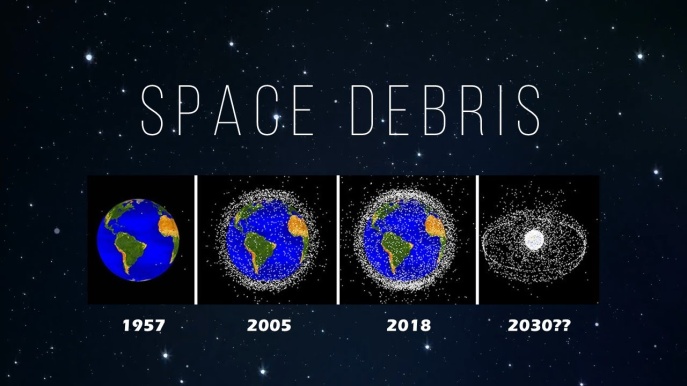Description

Disclaimer: Copyright infringement not intended.
Context
- The Australian Space Agency is investigating space debris found in farmland in the Snowy Mountains in southern NSW, after being notified by an astrophysicist who believes it to be from a SpaceX mission.
- Also, the debris from a large Chinese rocket – the Long March 5B — crashed to earth over the Pacific and the Indian oceans.
Space Debris
- Space junk is any piece of machinery or debris left by humans in space—principally in Earth orbit.
- These include dead satellites, fragments of rocket bodies and spacecraft etc.
Concerns
- Currently, an estimated 20,000 objects—including satellites and space debris—are crowding low-Earth orbit. It can be a hazard to active satellites and spacecraft.
- At orbital velocities, even the tiniest pieces of debris can disable an operational satellite.
- Potential collision threat to the space station.
- Earth orbit could even become impassable if the risk of collision grows too high.
- It could hinder our ability to use weather satellites, and hence to monitor weather changes.
Kessler syndrome
- This is an idea proposed by NASA scientist Donald Kessler in 1978.
- It says if there is too much space junk in orbit, it could result in a chain reaction where more and more objects will collide and create new space junk in the process, to the point where Earth's orbit became unusable – a Domino Effect.
- 12 fragmentation events have already taken place every year for the past two decades.
Mitigation Measures
- Developing Reusable spacecrafts.
- Designing and building spacecraft that can better withstand the harsh environment of space without disintegrating.
- Releasing stored energy and fuel so that defunct spacecraft don’t explode.
- Once a spacecraft's mission is over, moving it to a safer orbit. That is - A "graveyard orbit"high above the low-Earth space.
- Bringing it down using laser into Earth's atmosphere to burn up on re-entry as a neat disposal system.
- Capture debris or de-orbit old satellites.
- Charge operators “orbital-use fees”for every satellite put into orbit.
- Careful choice of orbits.
- Performing ‘collision avoidance manoeuvres’.
- Orbital lifetime reduction (accelerating the natural decay of space objects to reduce the time that they remain in orbit).
- International cooperation in the debris mitigation measures.
- Contributing to the efforts of the Inter-Agency Space Debris Coordination Committee (IADC)and United Nations Committee on the Peaceful Uses of Outer Space (UNCOPUOS).

Initiatives taken to tackle the problem
Inter-Agency Space Debris Coordination Committee
- IADC is an inter-governmental forum whose aim is to co-ordinate efforts to deal with debris in orbit around the Earth founded in 1993.
NORAD
- North American Aerospace Defense Command, is an initiative of the U.S. and Canada that shares selective debris data with many countries.
ClearSpace-1 Mission
- In this a "chaser" with its four robotic arms will grab the leftover of 2013 craft known as VESPA (Vega Secondary Payload Adapter) and drag it down to Earth's atmosphere where both will burn up. To be launched in 2025.
ELSA-d, Mission
- ELSA-d (End-of-Life Services b), will test technologies to capture an object in low-Earth orbit and move it to a lower altitude, where it will eventually burn up harmlessly in Earth's atmosphere.
Starship
- Space X Starship – the passenger‑carrying spacecraft once ready can collect and de-orbit space junk apart as well.
NEO-01’
- China launched a low Earth orbit robot prototype called ‘NEO-01’.
- It can scoop up space debris left behind by other spacecraft with a big net.
- NEO-01, was launched on Long March 6 rocket.
- NEO-01 will use a net to capture space debris and then burn it with its electric propulsion system.
- The NEO-01, will also peer into deep space to observe small celestial bodies.
- The 30kg robot will pave the way for future technologies capable of mining on asteroids.
Space Liability Convention of 1972
- Space Liability Convention of 1972 defines responsibility in case a space object causes harm. The treaty says that “a launching State shall be absolutely liable to pay compensation for damage caused by its space objects on the surface of the earth or to aircraft, and liable for damage due to its faults in space. The Convention also provides for procedures for the settlement of claims for damages.”
- However, there is no law against space junk crashing back to earth.
ISRO’s Efforts
‘Project NETRA’
- It is an early warning system in space to detect debris and other hazards to Indian satellites.
Other
- ISRO’s GSLV employs passivation of the Cryogenic Upper Stage at the end of its useful mission.
- ISRO's communication satellites are designed with adequate propellant margins for re-orbiting at the end of their useful life to a higher graveyard orbit.
- Successful example: INSAT-2C
Closing Thoughts
- Such multilateral efforts, alongside technological innovation, can ensure that the great space cleanup is well underway.
MUST READ:
SPACE SUSTAINIABILITY: https://www.iasgyan.in/daily-current-affairs/space-sustainiability
https://indianexpress.com/article/explained/explained-sci-tech/explained-as-chinese-rocket-plunges-into-ocean-the-risks-of-space-junk-and-its-uncontrolled-descent-8062710/
1.png)














